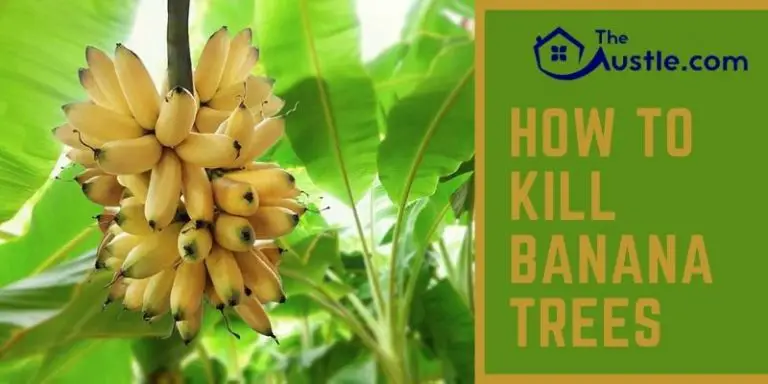Banana trees are a common sight in many tropical and subtropical areas. While these trees can provide a variety of benefits, such as delicious fruit and shade, there are times when they need to be removed. If you’re someone looking to learn more about bananas and how to get rid of the trees, you’ve come to the right place.

In this article, we’ll cover an introduction to banana trees and their benefits, as well as when to consider removing them. We’ll also explore the different methods for removing banana trees, the precautions to take when doing so, and tips for preventing them from growing back. Whether you’re a homeowner or a farmer, this guide will provide you with the information you need to effectively remove banana trees. So keep reading to learn more.
An Introduction to Banana Trees and Their Benefits.
Banana trees are a fascinating and versatile plant that offers numerous benefits to humans. These plants are native to tropical regions and have been cultivated for thousands of years, providing valuable nutrition and resources in many cultures.

One of the most well-known benefits of banana trees is their fruit. Bananas are a delicious and nutritious snack that is packed with essential vitamins and minerals, including potassium, vitamin C, and vitamin B6. They also contain high levels of fiber, which can help regulate digestion and promote overall health.
But bananas aren’t the only part of the tree that can be used. The leaves can be used for cooking or as a natural wrapping for food items. The trunk can also be harvested for its fibers, which can be woven into textiles or paper products.
Beyond their practical uses, banana trees also offer environmental benefits. They help prevent soil erosion by stabilizing steep slopes with their extensive root systems. Additionally, they absorb large amounts of carbon dioxide from the air during photosynthesis, making them an important ally in combatting climate change.
Overall, banana trees offer a wealth of benefits to both individuals and society as a whole. Whether you’re looking for a tasty snack or an eco-friendly resource for your next project, these amazing plants have something to offer everyone.
When to consider removing banana trees?
Banana trees are a common sight in tropical regions, and their fruit is enjoyed by many around the world. However, there are times when it may be necessary to consider removing banana trees from your property.
One reason to remove a banana tree is if it has become diseased or infested with pests. This can happen due to poor soil conditions or improper care, and can lead to the spread of disease or pests throughout your garden.
Another reason to remove a banana tree is if it has stopped producing fruit. Banana trees have a limited lifespan, and after several years they may stop producing fruit altogether. In this case, it may be more beneficial to remove the tree and replace it with a new one.
Additionally, if you live in an area prone to hurricanes or other severe weather events, you may want to consider removing banana trees before they become hazardous during high winds. The tall stature of these trees makes them susceptible to being uprooted in strong winds and damaging nearby structures.
In summary, while banana trees can add beauty and delicious fruit to your garden landscape, there are times when removal may be necessary for safety or health reasons. Keep an eye on your banana trees for signs of disease or pest infestation and know when their productive life cycle is coming towards an end so that you can make informed decisions about whether or not they should stay on your property.
The different methods for removing banana trees.
Banana trees are a staple in many tropical regions, but when it comes time to remove them, there are several methods to consider.

One of the most common methods involves cutting down the tree and digging out the roots. This can be a labor-intensive process, as banana tree roots can run deep and spread wide. However, it is also one of the most effective ways to ensure complete removal of the tree.
Alternatively, some people opt for chemical methods such as herbicides or salt treatments. While these options may seem more convenient at first glance, they can have negative impacts on soil health and surrounding vegetation.
For those looking for a more eco-friendly approach, there are also options such as using natural remedies like vinegar or boiling water to kill off the root system. However, these methods may not always result in complete removal of the tree and may require multiple attempts.
Ultimately, choosing which method to use depends on individual circumstances and preferences. Whether it’s through manual labor or alternative means, proper removal of banana trees is crucial for maintaining healthy soil and preventing unwanted regrowth.
The precautions to take when removing banana trees are.
When it comes to removing banana trees, there are some important precautions that must be taken in order to ensure a safe and successful removal. Whether you’re a seasoned gardener or just starting out, it’s essential to be aware of these precautions before attempting to remove any banana trees from your landscape.
First and foremost, it’s important to wear protective clothing when removing banana trees. This may include gloves, long sleeves, and pants. In addition, eye protection is also recommended as the sap from the tree can cause irritation if it gets into your eyes.

« if banana is apple apple is grapes
The Ultimate Guide to Knowing When Your Banana Bread is Done: Tips and Tricks for Perfect Baking! »
Next, you’ll want to make sure that the area around the tree is clear of any obstacles or hazards. This includes rocks, branches, and other debris that could potentially cause injury during the removal process.
Once you’ve cleared the area around the tree and put on your protective gear, it’s time to start cutting down the tree itself. This can be done using a saw or pruning shears depending on the size of the tree. It’s important to make clean cuts as close to ground level as possible in order to prevent regrowth.
After cutting down the tree itself, you’ll want to dig up as much of its roots as possible with a shovel or other digging tool. This will help prevent regrowth and ensure that your landscape remains clear of unwanted banana trees.
Finally, once all parts of the tree have been removed from your landscape it’s important dispose them properly so they don’t become an environmental hazard.
Remembering these simple precautions will help ensure that removing banana trees from your landscape is done safely and efficiently without causing harm either yourself or others in nearby vicinity!
Tips for preventing banana trees from growing back.
Banana trees are a beloved tropical fruit that have been cultivated for thousands of years. However, if you’re not careful, they can quickly take over your garden and become a nuisance. Fortunately, there are several tips for preventing banana trees from growing back.
Firstly, it’s important to remove the entire root system when digging up an old banana tree. Simply cutting down the tree will not be enough to prevent regrowth. Make sure to dig deep enough to remove any remaining roots or runners.
Another effective method is to use herbicides specifically designed for killing banana trees. These products contain chemicals that target the root system and prevent regrowth.
It’s also important to regularly prune any new shoots or suckers that may sprout up around the base of the tree. By doing so, you’ll prevent them from developing into fully grown trees and taking over your garden once again.

Lastly, consider planting your bananas in containers instead of directly in the ground. This will allow you greater control over their growth and make it easier to prevent unwanted regrowth.
By following these tips and being vigilant about preventing regrowth, you can enjoy delicious bananas without having them take over your garden!
Check out our other articles to find out even more about banana.
Bananas are a fantastic addition to any yard, and they come with many benefits. However, sometimes it is necessary to remove banana trees from your property. By understanding the different methods for removal, being mindful of precautions when removing them, and implementing strategies for preventing new growth you can ensure that your backyard remains peaceful and free of unwanted bananas! Check out our other articles to find out even more about banana.










